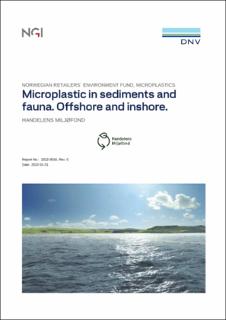| dc.contributor.author | Løseth, Mari Engvig | |
| dc.contributor.author | Tjønneland, Maren Valestrand | |
| dc.contributor.author | Pettersen, Arne | |
| dc.date.accessioned | 2022-06-20T11:27:28Z | |
| dc.date.available | 2022-06-20T11:27:28Z | |
| dc.date.issued | 2022-01-31 | |
| dc.identifier.uri | https://hdl.handle.net/11250/2999591 | |
| dc.description.abstract | Samples of sediment and sediment-dwelling organisms were obtained from the Norwegian Continental Shelf and fjords in Southern Norway. These are referred to as offshore areas and inshore areas, respectively. The sediments samples in inshore areas had significantly higher concentrations of microplastics/kg dw. (mean ± SD: 6 132 ± 5 537) than the offshore sediments (mean ± SD: 1 298 ± 788). This is most likely due to closer proximity to anthropogenic influences and sources of plastic emissions, as well as the presence of accumulation areas of marine debris closer to the coastline. The inshore polychaeta samples trended towards higher concentrations of microplastic items/g w.w. (mean ± SD: 1 773 ± 2 598), than the offshore polychaeta (mean ± SD: 485 ± 607), though due to the large statistical variations in individual biota samples, this cannot be considered statistically significant The most frequently detected plastic polymers were polyolefins (PE, PP), chlorinated-polyethers (PVC, chlorinated PE), PS and rubber in both sediments and polychaeta samples, however there was also large variation in polymer composition between corresponding sediment and polychaeta samples. The environmental impact of microplastics on benthic ecosystems are unknown and in need pf further investigation. The anticipated concentrations of microplastics are expected to increase in the foreseeable future, potentially leading to threshold concentrations, so it is of relevance to repeat this monitoring exercise to account for this. In general the study in this survey were comparable with that of a previous survey also looking at microplastic and sediment concentrations in this region, though some of the polychaete concentrations were higher in this study, but nevertheless the biota-to-sediment enrichment factors (11 to 4 864 gd.w/ gw.w.) were on the low range of the previous study (100 to 11 000 11 to 4 864 gd.w/ gw.w.). | en_US |
| dc.language.iso | eng | en_US |
| dc.publisher | NGI - Norges Geotekniske Institutt | en_US |
| dc.relation.ispartofseries | NGI Rapport;20210130-01-R | |
| dc.rights | Attribution-NonCommercial-NoDerivatives 4.0 Internasjonal | * |
| dc.rights.uri | http://creativecommons.org/licenses/by-nc-nd/4.0/deed.no | * |
| dc.subject | Microplastics | en_US |
| dc.subject | Sediments | en_US |
| dc.subject | Offshore | en_US |
| dc.subject | Inshore | en_US |
| dc.subject | FT-IR | en_US |
| dc.title | Microplastic in sediments and fauna. Offshore and inshore | en_US |
| dc.type | Report | en_US |
| dc.rights.holder | DNV | en_US |
| dc.source.pagenumber | 49 | en_US |
| dc.relation.project | Handelens miljøfond 10895 | en_US |

